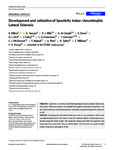Development and validation of Spasticity Index-Amyotrophic Lateral Sclerosis.
| dc.contributor.author | Milinis, K | |
| dc.contributor.author | Tennant, A | |
| dc.contributor.author | Mills, RJ | |
| dc.contributor.author | Al-Chalabi, A | |
| dc.contributor.author | Burke, G | |
| dc.contributor.author | Dick, DJ | |
| dc.contributor.author | Ealing, J | |
| dc.contributor.author | Hanemann, Clemens Oliver | |
| dc.contributor.author | Harrower, T | |
| dc.contributor.author | McDermott, CJ | |
| dc.contributor.author | Majeed, T | |
| dc.contributor.author | Pinto, A | |
| dc.contributor.author | Talbot, K | |
| dc.contributor.author | Williams, T | |
| dc.contributor.author | Young, CA | |
| dc.contributor.author | TONiC study group, | |
| dc.date.accessioned | 2018-05-09T07:42:46Z | |
| dc.date.issued | 2018-07 | |
| dc.identifier.issn | 0001-6314 | |
| dc.identifier.issn | 1600-0404 | |
| dc.identifier.uri | http://hdl.handle.net/10026.1/11413 | |
| dc.description.abstract |
OBJECTIVES: Spasticity is a common and disabling feature of amyotrophic lateral sclerosis (ALS). There are currently no validated ALS-specific measures of spasticity. The aim of this study was to develop and use a self-report outcome measure for spasticity in ALS. METHODS: Following semi-structured interviews with 11 ALS patients, a draft scale was administered across ALS clinics in the UK. Internal validity of the scale was examined using the Rasch model. The numerical rating scale (NRS) for spasticity and Leeds Spasticity scale (LSS) were co-administered. The final scale was used in a path model of spasticity and quality of life. RESULTS: A total of 465 patients (mean age 64.7 years (SD 10), 59% male) with ALS participated. Spasticity was reported by 80% of subjects. A pool of 71 items representing main themes of physical symptoms, negative impact and modifying factors was subject to an iterative process of item reduction by Rasch analysis resulting in a 20-item scale-the Spasticity Index for ALS (SI-ALS)-which was unidimensional and free from differential item functioning. Moderate correlations were found with LSS and NRS-spasticity. Incorporating the latent estimate of spasticity into a path model, greater spasticity reduced quality of life and motor function; higher motor function was associated with better quality of life. CONCLUSIONS: The SI-ALS is a disease-specific self-report scale, which provides a robust interval-level measure of spasticity in ALS. Spasticity has a substantial impact on quality of life in ALS. | |
| dc.format.extent | 47-54 | |
| dc.format.medium | Print-Electronic | |
| dc.language | en | |
| dc.language.iso | en | |
| dc.publisher | Wiley | |
| dc.subject | amyotrophic lateral sclerosis | |
| dc.subject | motor neurone disease | |
| dc.subject | patient reported outcome measures | |
| dc.subject | quality of life | |
| dc.subject | spasticity | |
| dc.title | Development and validation of Spasticity Index-Amyotrophic Lateral Sclerosis. | |
| dc.type | journal-article | |
| dc.type | Article | |
| plymouth.author-url | https://www.ncbi.nlm.nih.gov/pubmed/29468643 | |
| plymouth.issue | 1 | |
| plymouth.volume | 138 | |
| plymouth.publication-status | Published | |
| plymouth.journal | Acta Neurologica Scandinavica | |
| dc.identifier.doi | 10.1111/ane.12910 | |
| plymouth.organisational-group | /Plymouth | |
| plymouth.organisational-group | /Plymouth/Faculty of Health | |
| plymouth.organisational-group | /Plymouth/Faculty of Health/Peninsula Medical School | |
| plymouth.organisational-group | /Plymouth/REF 2021 Researchers by UoA | |
| plymouth.organisational-group | /Plymouth/REF 2021 Researchers by UoA/UoA01 Clinical Medicine | |
| plymouth.organisational-group | /Plymouth/Research Groups | |
| plymouth.organisational-group | /Plymouth/Research Groups/Institute of Translational and Stratified Medicine (ITSMED) | |
| plymouth.organisational-group | /Plymouth/Research Groups/Institute of Translational and Stratified Medicine (ITSMED)/CBR | |
| plymouth.organisational-group | /Plymouth/Users by role | |
| plymouth.organisational-group | /Plymouth/Users by role/Academics | |
| plymouth.organisational-group | /Plymouth/Users by role/Researchers in ResearchFish submission | |
| dc.publisher.place | Denmark | |
| dcterms.dateAccepted | 2018-01-23 | |
| dc.rights.embargodate | 2019-2-21 | |
| dc.identifier.eissn | 1600-0404 | |
| dc.rights.embargoperiod | Not known | |
| rioxxterms.versionofrecord | 10.1111/ane.12910 | |
| rioxxterms.licenseref.uri | http://www.rioxx.net/licenses/all-rights-reserved | |
| rioxxterms.type | Journal Article/Review |


